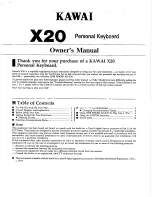
19
To program the sequencer, hit the S
EQUENCER
button; the S
EQUENCER
LED will light
indicating that the program matrix is now active for editing the sequences. Row 1 has
positions 1-8 of Sequence 1, and Row 2 has positions 9-16 of Sequence 1. Likewise
the remaining rows cover Sequences 2 – 4.
You can easily switch the matrix back and forth between normal Program edit mode
and sequence mode by hitting the S
EQUENCER
button. Assuming you have the
sequence destinations set, you can simply start a sequence (hit the S
TART
/S
TOP
button), and hear the result as you change the sequence step values, which range
from 0 to 100.
Note - when routing a sequencer to an oscillator, a sequence value of 24
corresponds to one octave, i.e. each step is one half a semitone.
You may find it easier at first to stop the sequence before adjusting each step. On
each “click” of the knob, it will trigger the envelopes so you can hear the current
setting of the knob. Once you go through all steps, then you can start the sequence to
hear the result, and make fine tuning changes while running.
All four sequences can have separate lengths. This is done by selecting
rst
(at the
end of the range after 100) as the step value. When this step is reached, the
sequence will reset to step one. For example, if you want a four step sequence,
simply set step 5 to
rst
.
Each sequence can have its own reset, so you will need to set the reset for all four
sequences if you want all of them to be the same length. And, if each is a different
length, the rests (see below) and clock swing settings will follow sequence 1, as will
the LEDs. In other words, the envelopes are always triggered from one sequence and
can’t be separately handled by each of the 4 sequences, which makes sense on a
monophonic instrument if you think about it.
Sequence 1 (rows 1 and 2) controls rests. If set to
off
(after
rst
at the end of the
range) there will not be a trigger to the envelopes on that step. As mentioned above,
the rests will end up in different places on other sequences if they are a different
length.
Using rests, resets, and different Clock Divides (half swing, swing, etc.) you can
achieve very complex sequences.
Another method of programming of pitched sequences is via a MIDI keyboard. Hold
the S
EQUENCER
button, and its LED will start blinking, indicating that the currently
selected sequence will accept key information over MIDI. Each MIDI note-on will be
saved in the current sequence location, and will automatically step to the next. It will
loop around from step 16 to 1 if you keep playing notes. MIDI notes below C2 (48) act
as rests. Note C2 will program a zero, C#2 a 2, etc.
Timing is not recorded when programmed from a keyboard; it is simply a convenience
feature for entering note values.
S
TART
/S
TOP
starts and stops the sequencer; the R
ESET
button will reset the sequence
to step one if the sequencer is running or not running.
Note – the R
ESET
button also acts as a MIDI all-notes-off, and resets all MIDI
controllers when hit while the sequencer is not running.
Summary of Contents for Evolver
Page 1: ...Evolver Operation Manual Dave Smith Instruments ...
Page 2: ......
Page 13: ...13 ...
Page 63: ......
















































